OSMO Action is DJI’s first attempt to enter the world of action cameras, which has been dominated by GoPro for a long time. As DJI has been creating solid cameras for its drones and handheld gimbals for years, it was just a matter of time for the above happened. They aimed high from the beginning, the OSMO Action (OA) promises about the same features as its contender’s flagship camera, the Hero 7 Black, for a more friendly price.
There are many action cameras on the market that promise 4K recording, but only few of them are capable of doing this with 60 frames per second while electronic image stabilization is activated. From the first Osmo Action reviews, it was obvious that DJI’s proprietary RockSteady in-camera stabilization does a really great job. Of course, it’s probably not as good as a mechanical gimbal.
DJI OSMO Action review, ratings & samples
Disclosure: I received this 4K action camera as part of a product review collaboration with DJI. Product specs and quality may vary according to the manufacturer’s reliability, so I cannot guarantee that you will get a product that performs exactly the same as seen in my article.
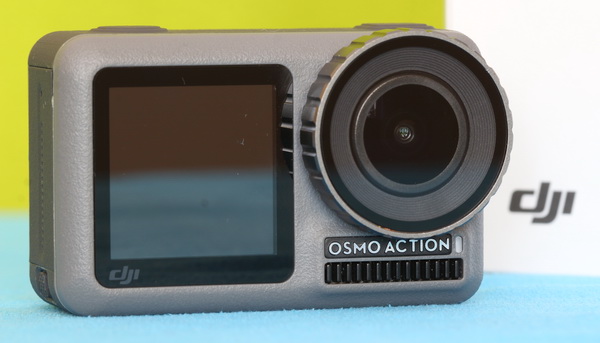
For July, DJI selected 9 lucky gadget lovers to get the Osmo Action for one month of testing. Unfortunately, like in case of the Osmo Pocket, after finishing my review I have to send it back.
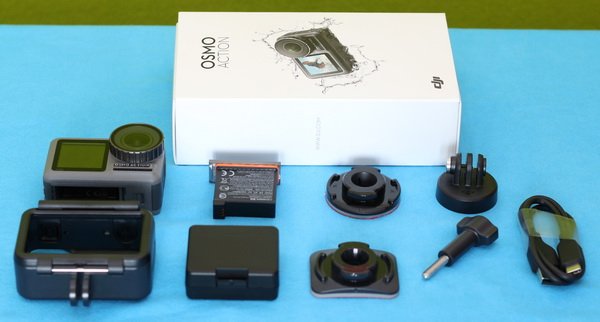
Inside the small box, besides the camera, I found the following accessories: 1300mAh Li-Ion battery, mounting frame, battery case, USB Type-C cable, quick-release base, curved adhesive mount, flat adhesive mount, and connector screw.
At a glance
As you would expect, the camera is rugged and durable (dust and shockproof), including waterproofing up to 11 meters without a dedicated case. In my opinion, for pool fun is just perfect out of the box, but as sea water is very corrosive, also when it dries, the salt crystals can scratch the lens and screens. I would suggest for snorkeling and diving a waterproof housing.
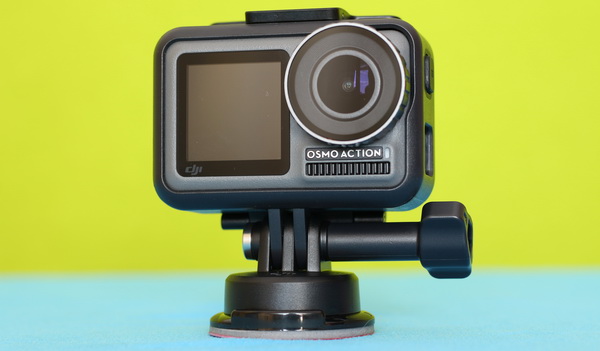
In addition to the rear 2.25″ touchscreen on the back, you have a second 1.4″ live-view color display on front for perfect selfies. Only one display can work at a time. You have also two status LEDs, one on top and one on front.
The 65 x 42 x 35 mm size camera body has nice grey finish with a subtle texture. On top, you have two buttons (Power & Shutter), a Status LED and a microphone. A third button on the side, labelled ‘QS’ (QuickSet), lets you switch between different working modes. The threaded lens shield can be conveniently removed, which allows easy replacement in case you break it or just want to use a neutral density (ND) filter instead of it.
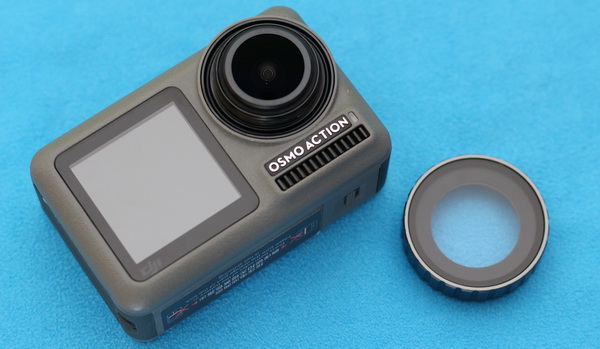
Right under the QS button, behind a tiny flap, are located the USB port and micro SD slot. The USB-C port allows charging the camera battery, transfer files from OSMO to your computer, as well as to attach certain accessories – such as external microphone. According to DJI’s specs, the microSD card slot accepts cards sizes up to 256GB.
If you owned before an action camera, you probably already found out how easily can be broken the battery compartment’s door. DJI, ingenuously moved the flap with rubber sealing from camera to the battery. You just need to insert the battery and you are done. In case that orange line is visible around the battery lockers, you need to push it harder in order to be completely sealed.
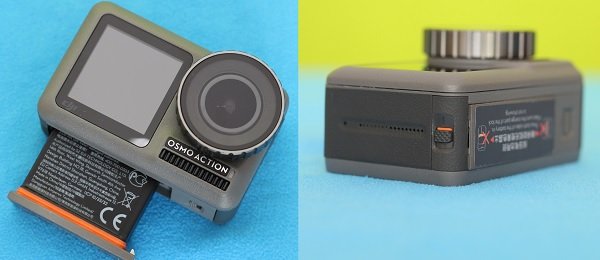
Like I mentioned above, couple of mounting accessories are included. l felt all solid and well built. Unlike other action camera mounting accessories, DJI’s quick release base adopts screw-in connection instead of slide-in one. At first look, the mounting screw is made by stainless steel, remains to be seen if it will rust or not.
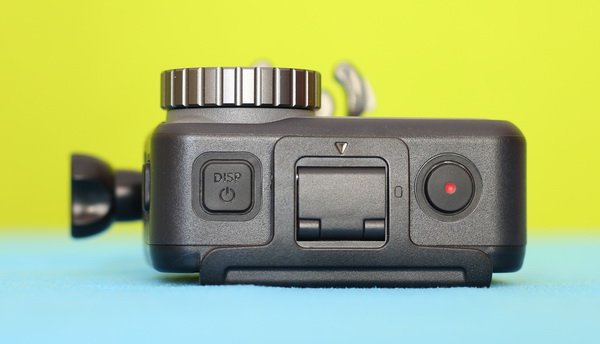
Osmo Action camera highlights
- Waterproof rugged design;
- Removable lens protector glass which can be replaced with ND or other optical filters;
- Two live-view screens (rear 2.25″ touchscreen and frontal 1.4″);
- Up to 4K@60fps video recording at 100 Mbps (with EIS enabled!);
- 12MP photos in still, burst, timed and time-lapse (JPEG or JPEG+RAW);
- ‘RockSteady’ electronic image stabilization;
- High dynamic range recording (HDR works up to 4K@30fps without EIS);
- 8 times slow-motion (1080p@240fps or 720P/240fps);
- Pro settings for fine-tune white balance, ISO, exposure for all video and photo modes;
- WiFi&Bluetooth connection for DJI Mimo APP control.
RockSteady (RS) stabilization
Like GoPro’s HyperSmooth, DJI’s RockSteady (RS) allows to obtain super stable videos even if the camera shacks during recording. This feature is very handy if you don’t like to use a mechanical gimbal or you just can’t – like underwater for example. In a nutshell, RockSteady represents an advanced electronic video stabilization which cleverly crops image in order to remove shakes and other movement resulting in a smoother video.
Unfortunately, due to the high CPU demand, this feature is available only for certain settings (resolution, frame rate and aspect ratio). Most disappointing is that you can’t use it together with HDR (high dynamic range). There is also a “cosmetic” issue using RS, it produces lag (delay) on display.
High Dynamic Range (HDR) videos
HDR – or High Dynamic Range filming is a quite unique feature in this market segment – not even the top-end Session 7 Black has it. HDR allows to capture more details from bright and dark areas in your videos. However, as I previously mentioned, you can’t use HDR with RockSteady, nor can you shoot at over 30 fps. This feature follows to be tested in various light conditions.
Controls and user interface
As I indicated previously, in addition to the rear touchscreen LCD, it has only 3 control buttons. If you own an Osmo Pocket, you will accommodate very quick with the touch-control. Main menu can be accessed by sliding your finger from top to bottom of the screen. There you can find 8 shortcuts: Save current settings, Screen brightness, Touch lock, Settings, Screen orientation, Spot metering On/Off, Voice control On/Off and Full front screen On/Off.
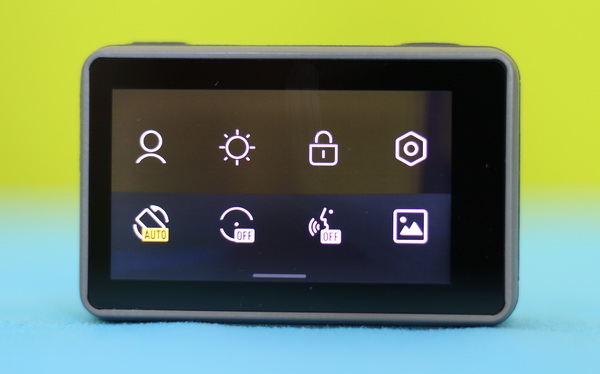
Settings menu allows to configure voice control, default working modes, QS button, Wirelesses connection, Sound level, Grid, Anti-flicker, Screen/Camera power Off, LED status, Language, Date/Time and memory card format. There you have also factory reset option and details about the camera and firmware version.
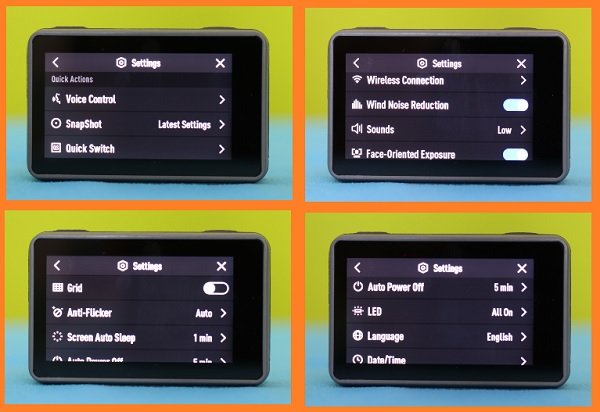
By swiping up from the bottom, you can customize the current mode. For videos, you can change resolution, aspect ratio, and frame rate. Here you can also activate/deactivate Rock Steady stabilization. Find below all resolution/frame rate options you have:
- 4K 16:9: 60/50/48/30/25/24 (RS for all);
- 4K 4:3: 30/25/24 (No RS);
- 2.7K 16:9: 60/50/48/30/25/24 (RS for all);
- 2.7K 4:3: 30/25/24 (No RS);
- 1080P: 240/200/120/100/60/50/48/30/25/24 (RS for 60FPS and below);
- 720P: 240/200 (No RockSteady).
The “QS” side button allows you to toggle between working modes. You have a total of 4 video (Standard video, HDR video, Slow-motion and Time-lapse) and 5 still photography (Single, Countdown, Timed, Burst and AEB) modes.
Like most action cameras, Osmo Action also has playback mode which allows to review the footage right on the field. This feature can be accessed by sliding your finger from left-to-right.
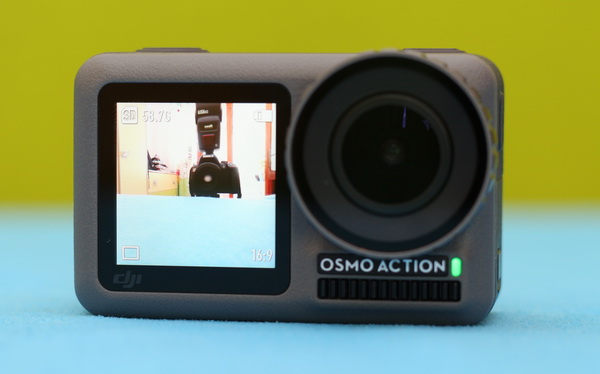
Switching between frontal and real screens can be done either by pressing twice the “QS” button, either by double tapping the rear screen with two fingers.
Osmo Action is also capable for hands-free operation. You can start/stop video recording or take still photos by giving voice commands. You can even toggle between front/rear screens. This feature is very handy when it is used as dashcam – you can control the camera while you keep your hand on the wheel.
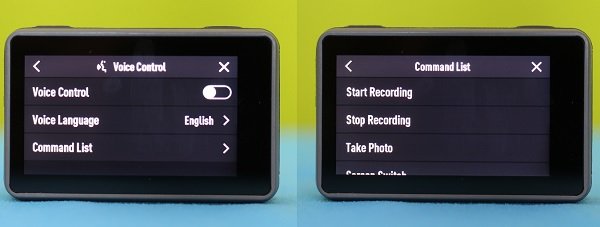
First weekend with the Osmo Action
After I turn it ON, warned me that I need to register it – you have 5 power cycles to do this. Registering is easy and can be done via the MiMO APP. While I had some issue to connect the camera to my Android phone, with my wife’s iPhone worked like a charm. After registering, next suggestion from DJI is to upgrade the camera’s firmware. After your approval, this step is made quick and smooth – in few minutes the OA restarts with the new software.
As I received the camera on Friday and I already scheduled to cut the grass in the weekend, I need it to combine the gardening activities with the testing one. Using a bike handlebar mount a attached the Osmo Action to my lawn mower.
Image and video quality
Firstly, I did 3 short tests: 4K@60fps with RockSteady, 4K@60fps without stabilization and 4K@30fps HDR. If you put side by side RS and non-RS videos, you will find that viewing angle is noticeably reduced. Luckily, the OA comes with wide angle lens, so loosing some FOV is not a big issue. RS does a really great job, the videos were smooth even if I cut the grass on terrain with a lot of unevenness. Next week, I will repeat the test using a 3-axis mechanical gimbal in order to see which stabilization provides better results.

Fish-eye (wide angle lens distortion) effect can be reduced by enabling “DeWarp” option. Unfortunately, there’s a tiny bit of extra cropping when you activate this feature.
While the Osmo Action is mainly for videos, it takes still photos with good sharpens and clarity. Dynamic range looks little limited without HDR. Hopefully, next firmware will bring HDR for photos as well. On full manual mode you can configure ISO, Max ISO, Shutter Speed and EV. You have option to take compressed jpeg photos or JPEG + DNG (uncompressed) photos.
Battery life
Finally, let’s talk a bit about the Osmo Action’s battery life. The removable 1300mAh battery allows roughly up to 2 hours of continuous working time. Battery life widely depends on which feature you turn on (RockSteady or HDR), also on recording resolution and frame rate. During my tests, I got almost 90 minutes of battery life from one fully charged battery (when shooting 4K@30fps with RockSteady enabled).
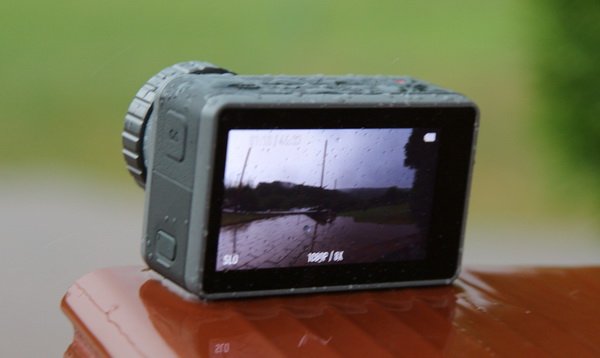
As charging time takes about 90 minutes, it is worth investing in one or more spare batteries. For example, you can get the Osmo Action Charging Kit, which includes 2 batteries with a case and a 3-way charging hub for only $69.
Price & Availability
Besides DJI’s online store, you can order the Osmo Action from the most reputable online retailers (worldwide and regional). While US customers must pay US$329 for it, EU customers must pay a bit more, around 379 Euros. At checkout, you can opt for memory cards (64GB or 128GB) and extra batteries. Although DJI has been promising for some time a 60-meter rated underwater housing for scuba divers, this one is still not available on their website. As an alternative, you can find third-party cases (30~40 meters) for 10-15 bucks, but you should use them at your own risk.
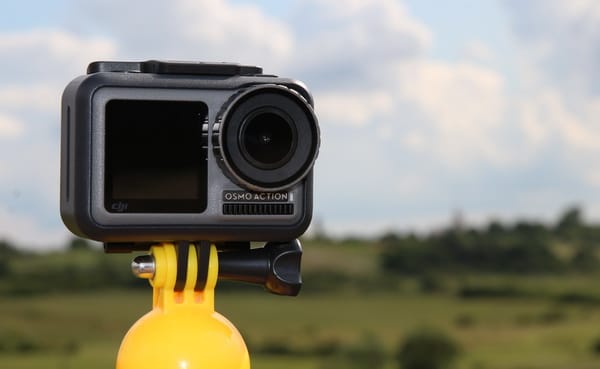
DJI Osmo Action vs GoPro 7 Black
| Osmo Action | GoPro 7 Black | |
| Image sensor | 1/2.3″ CMOS 12-megapixels | 1/2.3″ CMOS 12-megapixels |
| Max video resolution | 4K/60fps | 4K/60fps |
| Max video bitrate | 100Mbps | 78Mbps |
| HDR video | Yes | No |
| Video stabilization | EIS (RockSteady) | EIS (HyperSmooth) |
| Slow-motion videos | 8x (1080p/240fps) | 8x (1080p/240fps) |
| Live-streaming | No | Yes |
| Live-view display | Yes | No |
| Removable battery | Yes, 1300mAh | Yes, 1220mAh |
| Size | ~ 65 x 42 x 35 mm | ~ 62 x 45 x 28 mm |
| Weight | 124 grams | 116 grams |
| Native waterproofing | Yes, 11 meters | Yes, 10 meters |
| Price (US market) | USD $329 | USD $399 |
What’s new within the latest firmware? (v01.03.00.10 – 2019.06.10 release date)
- Optimized 8x slow motion video quality.
- Fixed issues:
- When recording for an extended period, the video and audio became out of sync;
- During playback, the camera occasionally restarted;
- While recording, the camera could not connect to DJI Mimo.
Useful resources for Osmo Action owners
- How to use Osmo Action (video by DJI Support);
- Genuine camera accessories;
- Official Osmo Action forum group;
- Osmo Action downloads (manual & firmware).

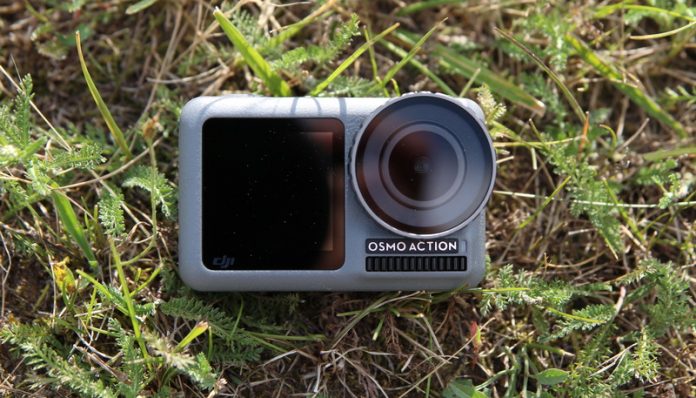
Visitor Rating: 5 Stars
Visitor Rating: 2 Stars
According to @OsitaLV DJI Osmo Action 2 with enhanced night vision, built-in GPS, and RockSteady 2.0 is coming!
Visitor Rating: 5 Stars
Hey guys does anyone know if a GoPro 7 waterproof case will work with an Osmo Action camera?
Will not fit. these two action cams have a different form factor and size.
I want to purchase a DJI Osmo Action and wondering if my old GoPro’s accessories can fit and be used with it? Thanks
Visitor Rating: 5 Stars
How can I use my Osmo Action as a webcam on my Windows 10 computer?
I am having a problem with my Osmo Action camera using SanDisk memory. ‘Card speed slow’ and sometimes it displays ‘error SD’.What should I do?
Your issue could be due to a faulty memory card or a fake one. Check the Sn# on SanDisk.com to find if it is a genuine micro SD card
Visitor Rating: 5 Stars
Visitor Rating: 3 Stars
Visitor Rating: 3 Stars
Can we expect a Osmo Action 2 in the near future?
I bought an Osmo Acton from eBay. The audio is not working properly. Also, find fog inside the lens and front screen… my next camera will be a GoPro 9
Did you know if DJI corrected the Hyperwarp issue FW 1.60 failure?
When it comes to the best action cameras you can buy right now, GoPro is without question the market leader. That said, it has some serious competition from DJI. This year the Drone King introduced its debut rugged action camera, the DJI Osmo Action, and in terms of spec it’s very similar to the ground-breaking GoPro Hero 7 Black!
Nice, detailed review!
Despite I’m a GoPro user since 2015 (4,6 and 7 Black), I have to admit that OA looks like s a serious candidate to compete against GoPro domination. The secondary live-view display makes me to think twice to upgrade to GoPo 8 or switch to Osmo Action.
Please, can you explain me the Dewarp mode? As I’ll be filming from various altitudes, the fish-eye effect kills my footage :(
Linear (aka Dewarp) mode is available in 16:9 format only. They softwarely crop and manipulate the image in order to look more natural. There is also a downside of using this feature, the the frame become much less wide…
did you tested the latest firmware with hyperlapse?
Nice try. But gopro is much better….
Visitor Rating: 5 Stars
Thanks for the great review! I’ m planning to purchase DJI OA next week, Is easy to activate on Android using MIMO app?
Yes, as we described in our review, activation consist in few easy steps and takes only 2 minutes.
After short snorkeling my Osmo Action is showing black screen and its not powering-off (only if I remove the battery) … Not responding at all :(. Just green LED in front
Any suggestion?
did you flashed the latest firmware any improvement?
Visitor Rating: 5 Stars
only 4.1 points for an almost perfect action camera?
Visitor Rating: 4 Stars
Visitor Rating: 4 Stars
Visitor Rating: 5 Stars